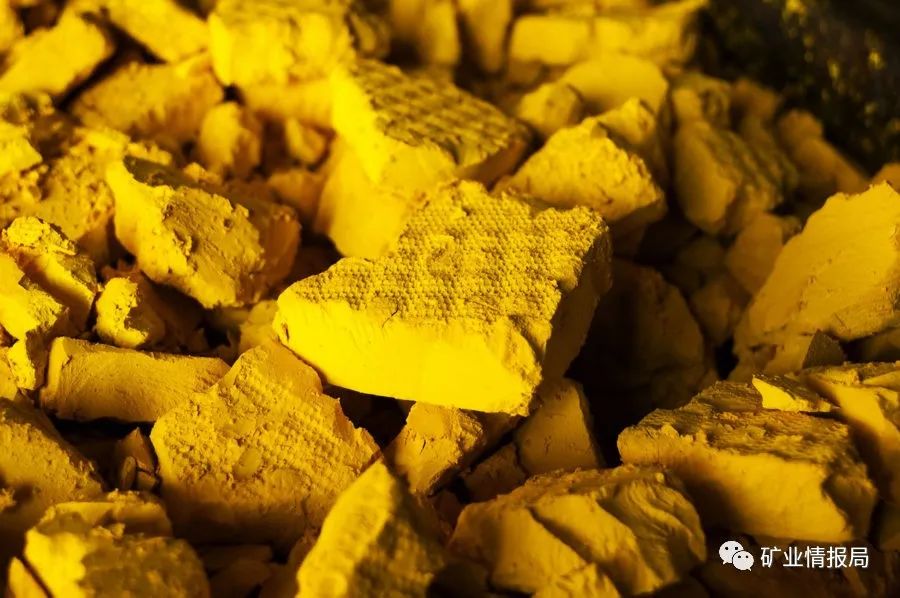Total global uranium production in 2021 totaled 48,303 tonnes, a slight increase of 1% from 47,731 tonnes in 2020. Based on estimates from the World Nuclear Energy Association (WNA) and data reported by companies, and based on 2021 reported/estimated production data, the following are the top ten uranium mines in the world.

01
Cigar Lake, Canada, 4693 tons
Cigar Lake is the world's largest and highest-grade uranium mine at 100 times the global average. Canadian uranium producer Cameco Corp owns a 50 percent stake in the uranium mine and is also the mine's operator. In July 2021, production resumed at the Cigar Lake uranium mine, which was responsible for processing and production at orano's McClean Lake smelter in Areva. Subject to the geological conditions of the uranium mine, Cameco was only able to develop a jet drilling system and a non-progressive mining method specifically applicable to the deposit, the zone formation freezing.
02
Kazakhstan Inkai - 1, 3449 tons
Inkai-1 is a very important uranium mine project located in Kazakhstan, operated by Inkai (Limited Liability Partnership), a joint venture between Cameco (40%) and Kazatomprom (60%) of Kazatomprom, a state-owned uranium miner in Kazakhstan.
03
Husab, Namibia, 3309 tons
The main body of the Husab project is the Rossing South orebody (about 5 km south of the Rossing mine and 45 km northeast of the port of Walvis Bay in Namibia). Swakop Uranium started development of the mine in February 2013, construction of the mine in 2014 and production at the end of 2016. Most of the products from the Husab uranium mine are supplied to China, and no more than 20% are sold globally through CGN Global Uranium.
04
Katco, Kazakhstan, 2840 tons
The Tortkuduk & Moinkum mine is located in the south of Kazakhstan and is owned and operated by Katco. The joint venture, Orano, holds 51 percent of the shares and Kazatomprom holds 49 percent of the shares.
05
Kazakhstan Karatau, 2561 tons
Karatau is an operating site-back mining consisting of Block 2 of the Budenovskoye Uranium Deposit (Chu-Sarysu Basin in the Suzak region of South Kazakhstan Oblast). Karatau employs around 620 people and is 50% owned by Uranium One (through the Kazakh Limited Liability Partnership joint venture Karatau), a subsidiary of Rosatom, and Kazatomprom.
06
Rossing, Namibia, 2444 tons
In 1966, Rio Tinto acquired authority for the low-grade Rossing deposit. Ten years later, in 1976, Namibia's first commercial uranium mine went into operation. On July 16, 2019, Rio Tinto announced the sale of all equity interest in rossing uranium ore to China National Nuclear Corporation (CNNC) for a total consideration of $6.5 million in initial cash and contingent payments not exceeding $100 million.
07
Kazakhstan SMCC, 2321 tons
SMCC is a joint venture (30% and 70% owned by Kazatomprom and Rosatom) and operates assets including the Akdala Deposit and Block 3 of the Inkai Deposit (located in the Suzak District of the Turkistan Region). The Akdala deposit was discovered in 1982 and commercialized in 2004. The Inkai deposit was discovered in 1976 and commercialized in Block 4 in 2007.
08
Four Mile, Australia, 2241 tonnes
The original site, Four Mile, is located approximately 115 km northeast of Leigh Creek, adjacent to the Beverley and Beverley North uranium mines. Oxygen and weak acid mining solvents are pumped into the ore body of Four Mile, where the dissolved uranium minerals are then pumped to the surface and loaded onto resins at the Beverley North Pannikan plant, where they are transferred to the Beverley processing plant for further processing, dehydration and export packaging.
09
Somair (Arlit), Niger, 1996 tons
The Arlit uranium mine is a large mine near Arlit (northern Niger) operated by Somaïr (Société des mines de l'Aïr), founded in 1968, owned by Orano, who holds 63.4% of the shares, and SOPAMIN (Société du Patrimoine des Mines du Niger), which holds 36.6% of the shares. Given the characteristics of the current processed ore, the annual uranium ore capacity in the region is around 2,000 tons.
10
Olympic Dam, Australia, 1992 tons
Located near the town of Roxby Downs, Olympic Dam is one of the world's most important deposits of copper, gold, silver and uranium, and is wholly owned and operated by BHP Billiton. The mine consists of both underground and above-ground mines and has a full range of processing facilities from ores and metals. The Olympic Dam was commissioned in 1988 and uranium production in 2021 was down 37% compared to 2020 due to maintenance at large smelters during this period.
Source of this article: NAI 500. If there is any infringement, please contact to delete it.
Disclaimer: This article represents only personal views and is not intended as a reference for investment. Investment is risky, and you need to be cautious when entering the market.